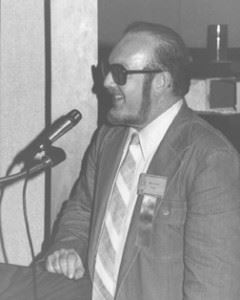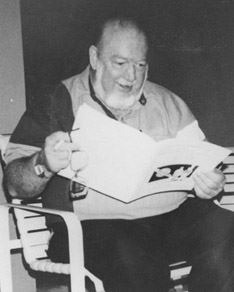

 Thirty years ago, as I was putting together the first of these conferences at Florida Atlantic University, I understood that I was doing something bizarre and quixotic. An academic venue for serious studies in fantasy and science fiction raised many more eyebrows then than it does today. In fact, the prevailing attitude of the establishment was hostile. In those few universities where “Sci Fi” was in the curriculum, it was considered a “gut course,” a sop to lazy students who wanted “popular” literature. It could not be taken seriously, and teachers who did so (like Carol McGuirk at Rutgers) were penalized, typed as second-rate scholars, lacking seriousness, etc. Teaching it, or worse, becoming “popular” while doing so, was running a big risk. No tenure. Ask Carol.
Thirty years ago, as I was putting together the first of these conferences at Florida Atlantic University, I understood that I was doing something bizarre and quixotic. An academic venue for serious studies in fantasy and science fiction raised many more eyebrows then than it does today. In fact, the prevailing attitude of the establishment was hostile. In those few universities where “Sci Fi” was in the curriculum, it was considered a “gut course,” a sop to lazy students who wanted “popular” literature. It could not be taken seriously, and teachers who did so (like Carol McGuirk at Rutgers) were penalized, typed as second-rate scholars, lacking seriousness, etc. Teaching it, or worse, becoming “popular” while doing so, was running a big risk. No tenure. Ask Carol.
My doctorate was in Medieval/Renaissance lit., but seven years earlier I had begun teaching a “special topics” course in Tolkien which evolved into a series of fantasy and science fiction courses. I had just finished a sabbatical, traveling about the country trying to read papers on my new academic interest. But there weren’t many places to read them. “Fannish” venues (usually called “cons”) hated scholarly critics, and rejected academic approaches, while academic venues looked down on the subject matter as trivial or unworthy of serious attention. (When I later read a Tolkien paper at the Eaton conference, using Heidegger’s comments on textuality as a critical perspective, a very vocal snob attacked me for “trivializing” Heidegger, setting pearls before swine, etc.)
I had managed to get one paper accepted by the Louisville 20th Century Literature Conference. It was lumped in with essays on “bodice rippers” and gothic novels, and most of the very small audience left before I got the podium. A small group of Tolkien fans at the Popular Culture Association accepted my paper on the folklore models for racial stereotypes in The Lord of the Rings. But they wouldn’t let me read it-the prevailing style for presentations was “talking it out,” an attempt to flout “stuffy academics.” The same attitude prevailed at a very small meeting of the SFRA, where half a dozen “serious fans” rambled on for an hour or so. Their presentations were basically book reviews, loose and unfocused, and often involved a good deal of fannish one-upmanship. (The group championed “hard science fiction” and condemned fantasy, and they echoed the prevailing anti-academic attitude among the writers they adulated.)
Meanwhile, the MLA, after a few years of “slumming,” had canceled their science fiction special interest group.
So I was astonished by the response to our first call for papers. We had sent five thousand fliers to colleges of arts and sciences in the summer of 1979, paid for by a gift from Margaret Gaines Swann, in memory of her son, the fantasist Thomas Burnett Swann. The bemused tolerance of my dean, Jack Suberman, got us an academic umbrella through the university’s Division of Continuing Education. But the conventional wisdom of the day told us to expect, if we were lucky, perhaps a dozen papers (one-quarter of one percent of the size of the mass mailing).
We got more than 600. They came in so fast we realized they could not have been written for us. Apparently, many academics had been trying to pursue these genre interests for years, without a venue, and we had become the “right place at the right time.”
I was elated, but then panic set in. I could not possibly read all those papers. My department chair, Howard Pearce, persuaded members of the English and Foreign Language departments to help us vet them. Since none of them were “experts” in the “field,” we had to set up some ad hoc guidelines. Our keynote speaker was to be Eric Rabkin, whose book, The Literature of the Fantastic, defined the mimetic milieu of the fantastic as “180 degrees” from “armchair reality.” (Rabkin was thinking of Henry James’s armchair, the viewpoint of the 19th century scientific materialist, the “realist” for whom even that “truth” which was “stranger than fiction” was inadmissible because it violated “probability.”) We adopted Rabkin’s general viewpoint. Appropriate subject matter would be “non-realistic,” the opposite of the prevailing mainstream mode. (Todorov’s genre study was bypassed as being far too narrowly focused.)
But there were numerous test cases on the margins of the mainstream. One paper on Robert Frost, for example, asserted the somewhat plausible premise that metaphor itself is fantastic. We couldn’t entirely refute that, but rejected the paper anyhow because we felt that the writer had missed the point of the conference.
To a large extent, since we lacked familiarity with specialized scholarship, what there was of it, the first papers were vetted on the basis of compositional values: clarity and persuasiveness. A little less than half of the submissions were accepted. And suddenly we had to find meeting rooms, hotel rooms, and other accommodations for many more conferees than we had envisioned.
It was a heady time. Surprise and excitement ran through the whole college, and we attracted a great many “locals” to our cause. Nobel prize-winner Isaac Singer, who lived in Miami Beach, agreed to be our Guest of Honor. He spoke to a full house in the University Theater. Rabkin’s keynote speech was roundly applauded, and all the attendees were obviously having a great time, despite being ferried from a dozen small motels back and forth to the campus on “Lolly the Trolley” (a streetcar cum motorbus popular for hauling partygoers about-we rented it).
Margaret Swann’s offer to fund us “again next year” drew a standing ovation at the banquet in the campus cafeteria, and we were off to a very promising start. In the years immediately following, we remedied obvious weaknesses in our initial planning. We set up an Association to oversee the academic structure of the conference, selecting “Division Heads” among the first attendees to vet the papers in their areas. And to avoid bopping back and forth to small motels, we moved the conference to the newly constructed Sheraton Hotel in Boca Raton, where meeting rooms were free (the university had charged us for them), and all the participants were lodged in one place.
To our delighted surprise, we were accepted in both academic and fannish circles for a while. We made the front page of Locus in our second year, and got the nickname “Swanncon.” Meanwhile, Greenwood Press gave us a continuing contract to publish selected papers from the conference (Scope of the Fantastic, etc.), and John Barth, a writer with a huge academic following, became our second Guest of Honor. His speech on Scheherazade ended with a rhetorical and syntactical tour de force that brought him a standing ovation. We have it on tape, for those who are curious. The second conference also premiered an avant-garde symphonic suite, Starscapes, by Thai composer Somtow Sucharitkul, also taped. Somtow himself directed the FAU Orchestra, with Barry Malzberg playing second violin in the ensemble.
From th e first we invited as many authors as we could, on the premise that interacting with them was a unique opportunity for academic critics. (For example, Samuel Delany told me, after listening to my paper on The Einstein Intersection: “That was a very white reading.”) And for several years we also conducted a writer’s workshop, headed by Gene Wolfe at first, and then James Gunn. The teachers in these workshops were many of the authors we invited each year, including Brian Aldiss (our second academic guest, on the basis of Billion Year Spree, the only comprehensive history of science fiction), Harlan Ellison, Fritz Leiber,Theodore Sturgeon, Kate Wilhelm, Damon Knight, Samuel Delany, Frederik Pohl, John Morressy, Barry Malzberg, etc.) My favorite alumna of these workshops was Sharon Baker, who published several striking novels before her untimely death of cancer in 1991.
e first we invited as many authors as we could, on the premise that interacting with them was a unique opportunity for academic critics. (For example, Samuel Delany told me, after listening to my paper on The Einstein Intersection: “That was a very white reading.”) And for several years we also conducted a writer’s workshop, headed by Gene Wolfe at first, and then James Gunn. The teachers in these workshops were many of the authors we invited each year, including Brian Aldiss (our second academic guest, on the basis of Billion Year Spree, the only comprehensive history of science fiction), Harlan Ellison, Fritz Leiber,Theodore Sturgeon, Kate Wilhelm, Damon Knight, Samuel Delany, Frederik Pohl, John Morressy, Barry Malzberg, etc.) My favorite alumna of these workshops was Sharon Baker, who published several striking novels before her untimely death of cancer in 1991.
ICFA 2 writers group
For five long years I continued to direct the conference as well as edit the monthly journal Fantasy Review. These tasks consumed my every waking moment, except for time spent in classes and committee meetings, etc. When ulcers and other problems undermined my health, I told Mrs. Swann that I would have to let someone else direct the conference. Roger Schlobin was then president of IAFA, and the structure of the conference as well as its reputation were established, and so I told her I was sure the conference could continue without me.
But there were hidden political forces at work. One of my colleagues (who had once been engaged to Tom Swann) attacked me for “usurping” the Swann Fund, and others charged me with “building an empire.” Behind my back, the Dean an d the head of the University Foundation convinced Mrs. Swann to establish a scholarship fund at FAU in her son’s name, rather than continue to fund the conference. (Harlan Ellison’s obscene podium performance the previous year had helped to alienate her affections.)
d the head of the University Foundation convinced Mrs. Swann to establish a scholarship fund at FAU in her son’s name, rather than continue to fund the conference. (Harlan Ellison’s obscene podium performance the previous year had helped to alienate her affections.)
Bob Collins reading ICFA 17 program
The withdrawal of her support left the conference homeless and fundless, and that would have been the end of us had it not been for the courage and daring of Roger Schlobin and Donald Morse. With monumental effort and at great personal risk they moved the sixth conference to Beaumont, Texas, with the tardily won support of Rice University. They even invited me as a Guest of Honor, or else I could not have attended, since I did not qualify for travel funds at FAU. A hundred and sixty-seven people showed up for that meeting, despite the widespread belief that “Swanncon” was dead (Locus had published its obituary the previous year). It was Roger’s finest hour, and I owe to him and to Donald a debt of gratitude I can never fully repay.
So, while it is gratifying to see that the thing I birthed in 1979 has now reached its thirtieth year, apparently prosperous and well, I cannot take credit for its well-being. Others have nurtured it to maturity-Marshall Tymn, Donald Palumbo, Chip Sullivan, Bill Senior, Chuck Nelson, Len Hatfield, Mike Levy, Farah Mendelsohn. Their stories need to be told.
--Bob Collins